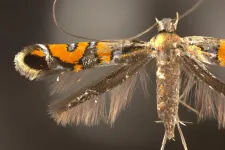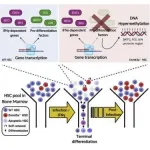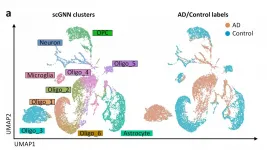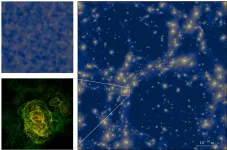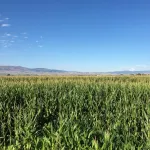(Press-News.org) Akito Kawahara was snapping pictures at a scenic outlook in Hawaii when he spotted the moth equivalent of a dodo.
An entomologist, Kawahara recognized the squiggly patterns on nearby plants as trails carved by leaf-mining caterpillars and lowered his camera to take a closer look. To his astonishment, he saw a tiny moth most experts assumed was extinct. It belonged to a genus known as Philodoria, a type of moth found only in Hawaii and one that hadn’t been documented in the wild since 1976.
“I thought, ‘Oh my God, there’s a Philodoria right here,’” said Kawahara, associate curator at the Florida Museum of Natural History’s McGuire Center for Lepidoptera and Biodiversity. “That was the beginning. It opened my eyes to the fact that at least one species had not gone extinct. Were there others?”
Kawahara’s chance sighting along a tourist footpath would kick off a hunt for the moths across all major volcanic islands of Hawaii, as well as in museum collections and back through time, resulting in the rediscovery of one of the archipelago’s oldest living lineages of native animals. Over the past eight years, Kawahara and collaborators have labored to fill gaps in our understanding of these poorly-studied insects: what they look like, where they live and what they eat. When the researchers began their work, 30 species of the slender, feathery moths were recorded in the scientific literature. That number has since grown to 51.
Now, the team is capping its project with a nearly 200-page-long study, the first to detail the natural history of all members of Philodoria, including 13 species new to science. The paper also offers a Hawaiian name for the genus, which had no known local epithet: Hunelele ‘elilau (HOO-neh-LEH-leh EH-lee-LAU), which roughly translates as a combination of “tiny flier” and “leaf excavator.”
“This is an amazing opportunity to add another key piece that deepens the Hawaiian story,” said study co-author Chris Johns, who carried out the project’s fieldwork during his doctoral studies in the Kawahara Lab. “Because of its rarity and isolated existence, Philodoria is as unique as it gets. The universe of a Philodoria species could be the size of a room.”
Many of the newly described species are named after native Hawaiian plants, places and people who have contributed to conservation on the islands, Kawahara said. One moth, Philodoria obamaorum, was christened in honor of Barack and Michelle Obama.
Shrinking habitat, disease and invasive species have wiped out much of Hawaii’s native flora and fauna, and more than 530 species on the islands are federally listed as endangered or threatened. Somehow, these micromoths, with a wingspan the length of an eyelash, have persisted.
But their restricted range and the scarcity of their host plants place them in danger of extinction. The researchers were unable to find living representatives of 10 Philodoria species known from museum specimens, and another 12 could be severely threatened, based on how scant their food sources are.
According to research led by Johns, the moths’ lineage likely dates back about 21 million years. Can they survive the next century?
An insect with deep island roots
Though Philodoria is found nowhere except Hawaii, it is related to the common caterpillars that tunnel inside the leaves of tomato plants and other garden staples, creating what look like intricate sketches as they chew through the tissue. The Hawaiian branch of the leaf-mining moth family, however, has a highly specialized diet, the product of millions of years of co-evolution with the islands’ plant life, including relatives of the iconic and endangered silversword plants.
“This tiny, tiny insect has a special relationship to Hawaiian plants,” said study lead author Shigeki Kobayashi, a former postdoctoral researcher in the Kawahara Lab and now a visiting researcher at Japan’s Osaka Prefecture University.
While the diet of the genus as a whole includes 12 families of Hawaiian plants, about 80% of Philodoria species feed exclusively on a single plant genus. More than half of the plant genera they eat contain threatened or endangered species, and three-quarters of the moth species themselves are restricted to one island or volcano. The insects and their host plants are among the many examples of life unique to the Hawaiian archipelago, an incubator for evolution before the arrival of humans.
It’s a delicate system in which the balance can easily be tipped. Invasive species, in particular, can disrupt an island’s native ecosystems with mind-boggling speed, Johns said.
“Within a couple of years, a forest that is fully functioning can be completely erased and replaced with non-native species,” he said. “This can happen in places that researchers just can’t reach. A pig or goat or bird could bring an invasive plant up there. It’s a huge problem.”
Blown or rafted from parts unknown, Philodoria likely first appeared on islands that today are nearly underwater. As new islands rose from the sea, the moths colonized them, and as host plants spread and diversified, the moths followed suit. Over time, they developed intimate links with certain plant species and now depend on them for survival.
Some of their leaf-mining relatives in other parts of the world have become so intertwined with their hosts that neither species can live without the other. In the South Pacific, a local species of plant relies on another leaf-mining moth species for pollination. In turn, the moth deposits its eggs in the plants’ flowers, which will later provide food for its offspring. Whether any members of Philodoria also have this mutually beneficial relationship with their host plants was a question Kawahara hoped to answer.
“The problem is that, in some cases, there’s only one or two of the plants left on the planet,” he said. “They’re often growing off steep cliffs, very hard to find, and you have to be in the right place at the right time to see them flowering. It was hard enough to find the larvae.”
Recruiting a Philodoria whisperer
Kawahara should know. After spotting that first moth as a postdoctoral researcher 10 years ago, he spent months combing the jungle for others with no success.
He had moved halfway across the world for a faculty position at the Florida Museum when Johns knocked on his door. Johns was a recent University of Florida anthropology graduate and a plant guy in search of a moth job. As he described his previous conservation work in Hawaii, an idea began to take shape in Kawahara’s mind. Would Johns be willing to scour the rainforest for an ultra-rare moth that had eluded researchers for nearly half a century?
Johns’ response: Game on.
“Most people think about Hawaii as this vacation spot with Mai-Tais and beaches, but it’s so much more than that,” he said. “It really all revolves around the culture, which revolves around its nature. There are so many things in Hawaii that are small and understated. The fact that Philodoria is this amazing story that no one knew about, just doing its thing – it’s an interesting reflection of what I think true Hawaii is.”
After a month on the islands, Johns appeared in Kawahara’s doorway in Gainesville with a small cooler. Inside were Philodoria.
“I was shocked,” Kawahara said. “I was convinced he was going to come back empty-handed. That was the best plane ticket I ever bought.”
The way to Philodoria is through its stomach
Johns’ strategy was to look not for the moths, but their host plants. He leaned on his ties with local conservation biologists to reach some of the islands’ most remote forests, accessible only by helicopter, four-by-four or a long hike. Once there, he searched for Philodoria’s food sources, using leads from papers published in the early 1900s and an eye already trained to distinguish native plant species from invasive ones.
It wasn’t easy. Some mountainsides were so difficult to get to, he had to be dropped off in the middle of a stream, the helicopter touching a single skid to a rock long enough for him to hop out. He would spot a piece of flagging tied to a faraway tree across a dense forest – that was the trail. Navigating it was “mostly falling,” he recalled.
“You’re on a volcano in the middle of the biggest ocean in the world,” Johns said. “When you get up into these places, you really get a sense of how quiet, still and slow the entire place is. You understand the isolation so much better.”
But due to the islands’ conelike shape, Johns could look out and see the rows of hotels and condominiums packing the distant coastline.
Micromoths often play important but overlooked roles in ecosystems, and Philodoria is no exception. The connections between the moths, their host plants and their habitat are so strong that the team could use traces of leaf mines on century-old herbarium specimens to provide clues to the insects’ current whereabouts.
In one study, Johns, Kawahara and collaborators at the Bishop Museum in Honolulu discovered the dried pupae of an undescribed and possibly extinct Philodoria species on a specimen of Hesperomannia in the Bishop’s herbarium. The plant specimen was collected in 1929 on the island of Lanai where today it no longer grows. In fact, Hesperomannia has become one of the islands’ most critically endangered plants, so rare it must be pollinated by hand – perhaps an example of a host plant that has lost its moth pollinator.
“The only way we could document this particular moth-plant interaction was through museum collections,” Kawahara said. “Whoever collected those leaves may not have even realized there were pupae attached, but that’s the only record we have of that moth.”
The lifecycle of Hawaii
The team also used the moths to revisit a classic evolutionary puzzle: When did plants and animals first appear in Hawaii?
On a map, Hawaii may look like a smattering of islands surrounded by ocean in all directions, but it’s actually the easternmost tip of a vast underwater mountain range that spans more than 3,600 miles, ending off the coast of Russia.
The main Hawaiian Islands – the youngest and largest – sit atop a hotspot, a single magma plume that has been birthing volcanoes for about 85 million years, which are sent on a slow westward journey by the movement of tectonic plates. The farther from the hotspot the islands travel, the more they sink and erode, finally disappearing beneath the ocean surface.
The hotspot has created an estimated 180,000 cubic miles of rock over its history. About 23 million years ago, it formed the Northwest Hawaiian Islands of Lisianski and Laysan. Once enormous landmasses rivalling the size of today’s main islands, they’re now in advanced stages of erosion: Lisianski’s highest point above sea level is a 40-foot sand dune, and Laysan – more than 800 nautical miles west of Honolulu – will likely be submerged this century.
The first of the main Hawaiian Islands to appear, Kauai, surfaced about 4.7 million years ago. Many researchers believe Hawaii’s existing native plants and animals date from this period. But evidence is mounting that some, including certain kinds of insects and spiders, hail from a much earlier era, when Lisianski and Laysan were in their prime.
This is the problem with using the ages of islands to timestamp the origin of species, Kawahara said. Plants and animals can predate the islands they now inhabit.
“Islands can also go extinct,” he said. “There are a lot of gaps in our knowledge, not just in terms of insects and plants, but also in terms of island geology.”
Hawaii’s flora and fauna may have been riding a conveyor belt of islands for millions of years, gradually vanishing from older islands and moving to new ones.
Philodoria is a good example.
Using a combination of DNA evidence, island ages and studies of closely related insect groups, Johns and Kawahara estimated that the moth lineage originated more than 21 million years ago, at least 19 million years before the formation of Kauai. If accurate, this would make the moths the islands’ oldest known living lineage of native arthropods – and possibly their oldest animal lineage alive today.
This timeline and fossil pollen evidence from the moths’ host plants suggest that Lisianski and Laysan were the moths’ first Hawaiian homes.
How did such tiny insects wind up on volcanoes in the middle of the ocean?
“Plants and animals arrived in Hawaii somehow,” Kawahara said. “How they got there, when they got there and how they ended up this way are some of the most fundamentally interesting evolutionary questions.”
Small moth, big dream
The future of Philodoria depends on the conservation of its host plants, Kawahara said. Like other native Hawaiian species, such as land snails, preserving habitat and protecting against invasive species are crucial to ensuring their survival.
While the Philodoria team helped put the shimmering moths back on the map, many questions remain. No one knows exactly how the insects interact with their environment or even the identity of the group’s ancestor. But for Kawahara, publishing a compilation of all known information about the moths carries personal weight.
“This was one of my dreams,” he said. “It’s not necessarily flashy science. It’s natural history. We’re doing it for the moths. We’re doing it for conservation. We’re doing it because it’s important.”
From one Hawaiian’s perspective, the moths are essential to the islands, regardless of whether or not we ever learn their precise roles within the ecosystem.
“Our culture depends on the existence of these moths and other insects and plants,” said collaborator and conservationist Keahi Bustamante in an award-winning video created by Johns. “It’s talked about. It’s put into songs and legends. It’s documented that we respect these things and they respect us in a way that allows us to survive.”
The study was published in Zootaxa.
Funding for the research was provided by the National Science Foundation, the National Geographic Society, the Entomological Society of America, the University of Florida Entomology and Nematology Department, the Florida Museum of Natural History, the UF Tropical Conservation and Development Program, the International Biodiversity Foundation and the Society for Systematic Biologists.
Sources: Akito Kawahara, kawahara@flmnh.ufl.edu, 352-273-2018;
Chris Johns, johns.chris.a@gmail.com;
Shigeki Kobayashi, crossroad1994@hotmail.co.jp
Study introduces 13 new, threatened species of sparkly moths from Hawaii
One of the islands' oldest animal groups, can these tiny insects survive the next century?
2021-03-25
ELSE PRESS RELEASES FROM THIS DATE:
Consumers will dub activist brands as 'woke-washers' if they cannot prove moral competency
2021-03-25
New research shows that consumers judge 'activist brands' based on how morally competent they are perceived to be when challenging free speech.
The report, co-authored by experts at the Business School (formerly Cass), Birkbeck, University of London and the University of Sussex Business School explains that stakeholders draw their conclusions on the biggest brands by measuring three moral skills: sensitivity, vision, and integration.
Lacking these traits, a brand raising controversy is judged as transgressing, reproducing and manipulating the boundaries of free speech. Displaying these traits proves the brand is not merely 'woke-washing' ...
Study reveals how long-term infection and inflammation impairs immune response as we age
2021-03-25
HOUSTON, TX - March 25, 2021 - Humans are born with tens of thousands of hematopoietic stem cells (HSCs) that collectively ensure lifelong production of blood and immune cells that protect us from infections. HSCs can either duplicate to produce more stem cell progeny or differentiate to produce distinct immune cell lineages, an extremely critical decision that ensures that the body achieves the fine balance between having enough immune cells to fight invaders while still retaining enough HSCs to maintain future blood production. As we age, HSCs accumulate mutations that lead to the ...
The case of the cloudy filters: Solving the mystery of the degrading sunlight detectors
2021-03-25
More than 150 years ago, the Sun blasted Earth with a massive cloud of hot charged particles. This plasma blob generated a magnetic storm on Earth that caused sparks to leap out of telegraph equipment and even started a few fires. Now called the Carrington Event, after one of the astronomers who observed it, a magnetic storm like this could happen again anytime, only now it would affect more than telegraphs: It could damage or cause outages in wireless phone networks, GPS systems, electrical grids powering life-saving medical equipment and more.
Sun-facing satellites monitor the Sun's ultraviolet (UV) light to give us advance warning of solar storms, both big ones that could cause a Carrington-like ...
Gene discovery confirms role of serine deficiency in rare eye disease
2021-03-25
NEW YORK, NY--Treatments for a rare retinal disease may be on the horizon after a new study has identified gene variants that cause a metabolic deficiency in the eye.
The disease, macular telangiectasia type 2 (MacTel), has been a research focus of Rando Allikmets, PhD, a pioneer in the genetics of eye diseases, for nearly 15 years. MacTel occurs in approximately 1 in 5,000 adults over age 40 and slowly causes a significant loss of central vision, which can impair driving, reading, and other activities.
"MacTel is clearly a genetic disease because it tends to run in families, but it's been a tough nut to crack," says Allikmets, the William and Donna Acquavella Professor of Ophthalmic Sciences ...
Moffitt researchers use mathematical modeling to analyze dynamics of CAR T-cell therapy
2021-03-25
TAMPA, Fla. -- Chimeric antigen receptor T-cell therapy, or CAR T, is a relatively new type of therapy approved to treat several types of aggressive B cell leukemias and lymphomas. Many patients have strong responses to CAR T; however, some have only a short response and develop disease progression quickly. Unfortunately, it is not completely understood why these patients have progression. In an article published in Proceedings of the Royal Society B, Moffitt Cancer Center researchers use mathematical modeling to help explain why CAR T cells work in some patients and not in others.
CAR T is a type of personalized immunotherapy that uses a patient's own T ...
New UCF nanotech gives boost to detection of cancer and disease
2021-03-25
ORLANDO, March 25, 2021 - Early screening can mean the difference between life and death in a cancer and disease diagnosis. That's why University of Central Florida researchers are working to develop a new screening technique that's more than 300 times as effective at detecting a biomarker for diseases like cancer than current methods.
The technique, which was detailed recently in the Journal of the American Chemical Society, uses nanoparticles with nickel-rich cores and platinum-rich shells to increase the sensitivity of an enzyme-linked immunosorbent assay (ELISA).
ELISA is a test ...
A new way to visualize mountains of biological data
2021-03-25
Studying genetic material on a cellular level, such as single-cell RNA-sequencing, can provide scientists with a detailed, high-resolution view of biological processes at work. This level of detail helps scientists determine the health of tissues and organs, and better understand the development of diseases such as Alzheimer's that impacts millions of people. However, a lot of data is also generated, and leads to the need for an efficient, easy-to-use way to analyze it.
Now, a team of engineers and scientists from the University of Missouri and the Ohio State University have created a new way to analyze data from single-cell RNA-sequencing ...
The very first structures in the Universe
2021-03-25
The very first moments of the Universe can be reconstructed mathematically even though they cannot be observed directly. Physicists from the Universities of Göttingen and Auckland (New Zealand) have greatly improved the ability of complex computer simulations to describe this early epoch. They discovered that a complex network of structures can form in the first trillionth of a second after the Big Bang. The behaviour of these objects mimics the distribution of galaxies in today's Universe. In contrast to today, however, these primordial structures are microscopically small. Typical clumps have masses of only a few grams and fit into volumes much smaller than present-day elementary particles. The results of the study have been published ...
Size of grass blades offers better understanding of their vulnerability to climate change
2021-03-25
One-third of the Earth's surface is covered by more than 11,000 grass species -- including crops like wheat, corn, rice and sugar cane that account for the bulk of the world's agricultural food production and important biofuels. But grass is so common that few people realize how diverse and important it really is.
Research published today in the journal Nature provides insights that scientists could use not only to improve crop design but also to more accurately model the effects of climate change. It also offers new clues that could help scientists use ...
'Break a leg' not so lucky when it leads to limb deformities
2021-03-25
Orthopaedic researchers are one step closer to preventing life-long arm and leg deformities from childhood fractures that do not heal properly.
A new study led by the University of South Australia and published in the journal Bone, sheds light on the role that a protein plays in this process.
Lead author Dr Michelle Su says that because children's bones are still growing, an injury to the growth plate can lead to a limb in a shortened position, compared to the unaffected side.
"Cartilage tissue near the ends of long bones is known as the growth plate that is responsible for bone growth in children and, unfortunately, 30 per cent of childhood and teen fractures involve this growth ...
LAST 30 PRESS RELEASES:
B cells transiently unlock their plasticity, risking lymphoma development
Advanced AI dodel predicts spoken language outcomes in deaf children after cochlear implants
Multimodal imaging-based cerebral blood flow prediction model development in simulated microgravity
Accelerated streaming subgraph matching framework is faster, more robust, and scalable
Gestational diabetes rose every year in the US since 2016
OHSU researchers find breast cancer drug boosts leukemia treatment
Fear and medical misinformation regarding risk of progression or recurrence among patients with breast cancer
Glucagonlike peptide-1 receptor agonists and asthma risk in adolescents with obesity
Reviving dormant immunity: Millimeter waves reprogram the immunosuppressive microenvironment to potentiate immunotherapy without obvious side effects
Safety decision-making for autonomous vehicles integrating passenger physiological states by fNIRS
Fires could emit more air pollution than previously estimated
A new way to map how cells choose their fate
Numbers in our sights affect how we perceive space
SIMJ announces global collaborative book project in commemoration of its 75th anniversary
Air pollution exposure and birth weight
Obstructive sleep apnea risk and mental health conditions among older adults
How talking slows eye movements behind the wheel
The Ceramic Society of Japan’s Oxoate Ceramics Research Association launches new international book project
Heart-brain connection: international study reveals the role of the vagus nerve in keeping the heart young
Researchers identify Rb1 as a predictive biomarker for a new therapeutic strategy in some breast cancers
Survey reveals ethical gaps slowing AI adoption in pediatric surgery
Stimulant ADHD medications work differently than thought
AI overestimates how smart people are, according to HSE economists
HSE researchers create genome-wide map of quadruplexes
Scientists boost cell "powerhouses" to burn more calories
Automatic label checking: The missing step in making reliable medical AI
Low daily alcohol intake linked to 50% heightened mouth cancer risk in India
American Meteorological Society announces Rick Spinrad as 2026 President-Elect
Biomass-based carbon capture spotlighted in newly released global climate webinar recording
Illuminating invisible nano pollutants: advanced bioimaging tracks the full journey of emerging nanoscale contaminants in living systems
[Press-News.org] Study introduces 13 new, threatened species of sparkly moths from HawaiiOne of the islands' oldest animal groups, can these tiny insects survive the next century?
